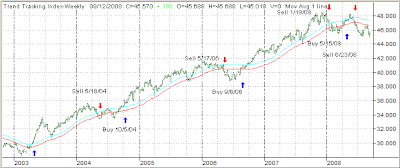 The markets had another volatile session yesterday with swings from high to low of some 300 points on the Dow. The Fed’s refusal to lower interest rates pulled the major indexes sharply lower, but buying resumed and we closed in positive territory.
The markets had another volatile session yesterday with swings from high to low of some 300 points on the Dow. The Fed’s refusal to lower interest rates pulled the major indexes sharply lower, but buying resumed and we closed in positive territory.
The only reason we closed higher was when the remote possibility surfaced that the Fed/US Treasury was considering a $75 billion bailout package to prolong the life of insurer AIG. Yes, it appears if you’re big and stupid, the government will not allow you to fail. How this will ultimately play out is unknown, but we will probably find out more throughout the day.
For months, I have been harping on the fact that while you’re riding this bear market out, you should use a U.S. Treasury only money market option. Trying to attempt to scalp an extra percentage point return by staying in a risky fund simply does not pay off.
MarketWatch reports that another “Money Market Breaks The Buck,” and also freezes redemptions. Can you imagine you have cash in an account, which you might need to cover expenses on a monthly basis, and suddenly your account is frozen? Even if only for 7 days?
Here are bits of the story:
One of the first and largest money market funds has put a seven-day freeze on investor redemptions after the net asset value of its shares fell below $1, in a rare instance in the fund industry of what is called “breaking the buck.”
RFIXX, a $64 billion fund managed by money market fund inventor The Reserve, said late Tuesday that its $785 million holding of Lehman Brothers Holdings debt has been valued at zero.
As of 4 p.m., the value of the fund’s share was 97 cents. The Reserve said that redemption requests received before 3 p.m. will be paid out at $1 a share.
While Primary Fund’s Lehman holding was small compared to the fund’s overall size, the fact that it froze redemptions reflects a surge in redemption requests by investors.
“Effective today and until further notice, the proceeds of redemptions from The Primary Fund will not be transmitted to the redeeming investor for a period of up to seven calendar days after the redemption,” The Reserve said in a statement. Officials at the company declined to comment further.
Money market funds pride themselves on their liquidity and the safety of their investments. All money market shares are priced at $1 — a figure so important to the industry that fund companies take losses to keep the share price from dipping below $1, which is known as breaking the buck.
“They didn’t just break the buck, they shattered it,” said Don Phillips, managing director at investment research firm Morningstar Inc.
Phillips said the fact that The Reserve had to break the buck reflects the seriousness of its troubles. “People say that if you break the buck on a money market fund you’re saying that you don’t want to be in the money market business anymore.”
An extra percentage point in money market, while desirable, is not going to make you rich. Don’t be stupid and chase yield in an economic environment where the unthinkable can happen. Safety of your assets should be your priority number one. Don’t screw it up!






